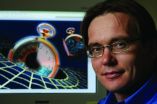(Press-News.org) CORVALLIS, Ore. - Engineers at Oregon State University have identified a method to rapidly prepare frozen red blood cells for transfusions, which may offer an important new way to manage the world's blood supply.
It's already possible to cryopreserve human red blood cells in the presence of 40 percent glycerol, but is rarely done because of the time-consuming process to thaw and remove the glycerol from the blood. This can take an hour or more and makes it logistically difficult to use frozen blood.
However, some initial experiments and computer modeling of a proposed new process suggest that this hour-long process can be reduced to as little as three minutes, using a membrane-based, microfluidic device. This could make it far more feasible to use frozen blood in emergency or time-constrained medical situations.
The findings were just reported in the journal Biomicrofluidics.
"Only a small fraction of our blood supply is now frozen, because it's often impractical to wait so long when a transfusion is needed immediately," said Adam Higgins, an expert in medical bioprocessing and associate professor in the OSU School of Chemical, Biological and Environmental Engineering.
"Because of that, our entire system depends on constantly balancing the use and supply of blood products that can only last six weeks or less with refrigeration," he said. "This is difficult, and can lead to loss of outdated blood, periodic shortages, and other inefficiencies that could be solved with the use of frozen blood."
Researchers in the OSU College of Engineering, however, have become national leaders in the science of microfluidics, which uses microchannel-based approaches to processing fluids for various purposes, ranging from more efficient heat pumps to innovative methods for kidney dialysis.
In the case of frozen blood, extremely tiny microchannel plates and membranes could be used to precisely control removal of glycerol from blood at a time scale of seconds. This would allow much more rapid thawing of frozen blood, which isn't possible using the centrifugal cell washers that have been around for decades and are the only other way to remove glycerol from the blood.
The new approach should work, OSU experts say.
"Our results pave the way for development of a clinical device for ultra-rapid glycerol extraction, which would greatly improve the logistics of blood banking," the researchers wrote in their report.
According to their report, each year more than 100 million blood donations are collected worldwide, enabling millions of life-saving transfusions. But refrigerated blood has a short shelf life, and some recent studies even suggest that "older" blood being used within what's believed to be an acceptable refrigeration period may be linked to severe complications.
Cryopreservation could extend the shelf life of blood from weeks to years; dramatically smooth out the undependable supplies of blood; and according to recent research, produce cryopreserved red blood cells that have superior biochemical and tissue oxygenation capabilities compared to refrigerated red blood cells.
This research has been supported by a CAREER Award from the National Science Foundation.
In continued studies, researchers said they hope to create working prototypes of the needed technology for further development and testing of the concept. An optimized process may also be even faster than the three minutes now being predicted, they said.
INFORMATION:
RENO, Nev. - The everyday use of a GPS device might be to find your way around town or even navigate a hiking trail, but for two physicists, the Global Positioning System might be a tool in directly detecting and measuring dark matter, so far an elusive but ubiquitous form of matter responsible for the formation of galaxies.
Andrei Derevianko, of the University of Nevada, Reno, and his colleague Maxim Pospelov, of the University of Victoria and the Perimeter Institute for Theoretical Physics in Canada, have proposed a method for a dark-matter search with GPS satellites ...
LIVERMORE, Calif. - Lawrence Livermore National Laboratory researchers have developed an efficient method to measure residual stress in metal parts produced by powder-bed fusion additive manufacturing.
This 3D printing process produces metal parts layer by layer using a high-energy laser beam to fuse metal powder particles. When each layer is complete, the build platform moves downward by the thickness of one layer, and a new powder layer is spread on the previous layer.
While this process is able to produce quality parts and components, residual stress is a major ...
The race to make computer components smaller and faster and use less power is pushing the limits of the properties of electrons in a material. Photonic systems could eventually replace electronic ones, but the fundamentals of computation, mixing two inputs into a single output, currently require too much space and power when done with light.
Researchers at the University of Pennsylvania have engineered a nanowire system that could pave the way for this ability, combining two light waves to produce a third with a different frequency and using an optical cavity to amplify ...
Rice University scientists have invented a novel cathode that may make cheap, flexible dye-sensitized solar cells practical.
The Rice lab of materials scientist Jun Lou created the new cathode, one of the two electrodes in batteries, from nanotubes that are seamlessly bonded to graphene and replaces the expensive and brittle platinum-based materials often used in earlier versions.
The discovery was reported online in the Royal Society of Chemistry's Journal of Materials Chemistry A.
Dye-sensitized solar cells have been in development since 1988 and have been the subject ...
Scientists using a microbe that occurs naturally in eastern cottonwood trees have boosted the ability of two other plants - willow and lawn grass - to withstand the withering effects of the nasty industrial pollutant phenanthrene and take up 25 to 40 percent more of the pollutant than untreated plants.
The approach could avoid the regulatory hurdles imposed on transgenic plants - plants with genes inserted from or exchanged with other plant or animal species - that have shown promise in phytoremediation, the process of using plants to remove toxins from contaminated sites, ...
More than a decade ago, researchers from Brigham and Women's Hospital (BWH) demonstrated that a high dose statin, which lowered cholesterol further than a regular dose statin, provided better clinical outcomes. But questions remained about whether further reducing cholesterol would be even more effective in reducing cardiovascular-related events.
Now, results of the highly anticipated IMProved Reduction of Outcomes: Vytorin Efficacy International Trial (IMPROVE-IT), co-led by researchers at BWH and Duke Medicine, indicate that adding a second drug, ezetimibe, that blocks ...
WCS, NASA, And other conservation and remote sensing agencies, universities and NGOs focus on top 10 conservation questions for satellite technology
Remote sensing has and can continue to play a critical role in conserving Earth's biological diversity
Protected area management is a key use of remote sensing data
Newly formed Conservation Remote Sensing Network to apply remote sensing data to conservation challenges
NEW YORK (November 17, 2014)--Scientists from the WCS (Wildlife Conservation Society), NASA, and other organizations have partnered to focus global attention ...
Harvard Stem Cell Institute (HSCI) researchers, representing five Harvard departments and affiliated institutions as well as the Massachusetts Institute of Technology (MIT), have demonstrated that adult cells, reprogrammed into another cell type in a living animal, can remain functional over a long period.
The work by Joe Zhou, an associate professor in Harvard's Department of Stem Cell and Regenerative Biology, and his collaborators is an important advance in the effort to develop cell-based therapies for tissue repair, and specifically in the effort to develop improved ...
HOUSTON - (Nov. 17, 2014) - Offering small financial incentives doubles smoking cessation rates among socioeconomically disadvantaged smokers, according to research from The University of Texas Health Science Center at Houston (UTHealth). The findings were published last week in the American Journal of Public Health.
Tobacco use is the leading cause of preventable death in the United States, according to the Centers for Disease Control and Prevention. Thanks to public health efforts, smoking rates have declined to 18 percent among American adults. However, nearly 30 percent ...
If your surname reveals that you descended from the "in" crowd in the England of 1066--the Norman Conquerors--then even now you are more likely than the average Brit to be upper class. To a surprising degree, the social status of your ancestors many generations in the past still exerts an influence on your life chances, say Gregory Clark of the University of California, Davis, in the US and Neil Cummins of the London School of Economics in the UK. They used the Oxbridge attendance of people with rare English surnames (last names) to track social mobility from 1170 to 2012. ...





